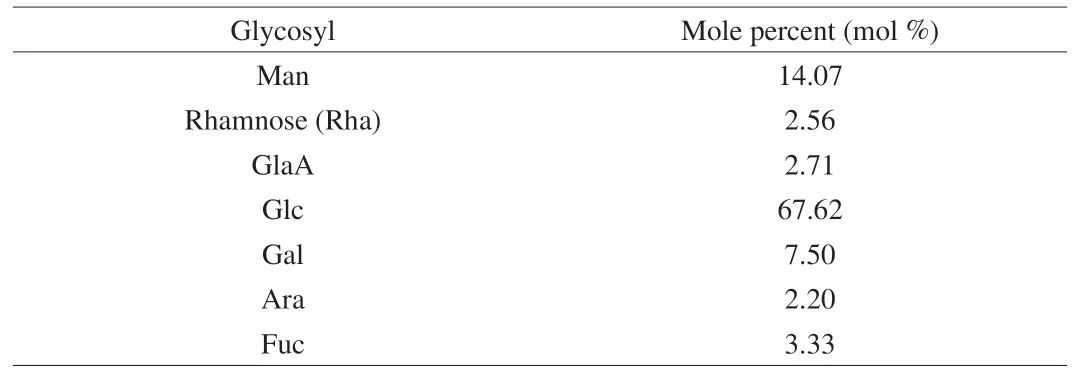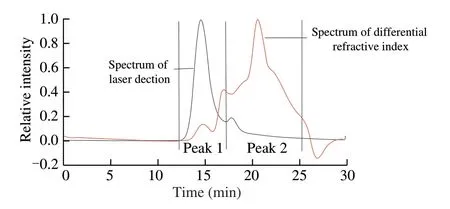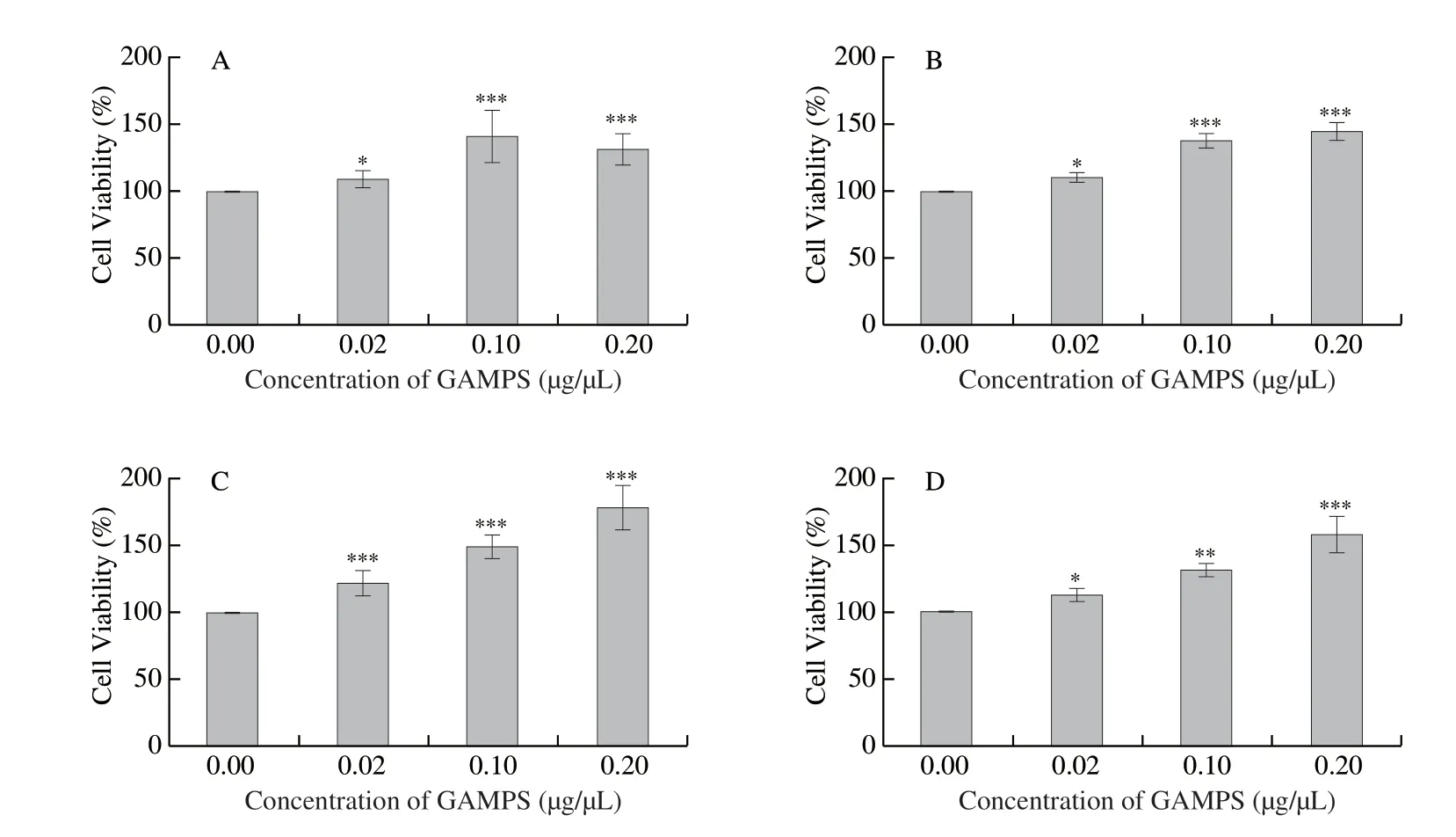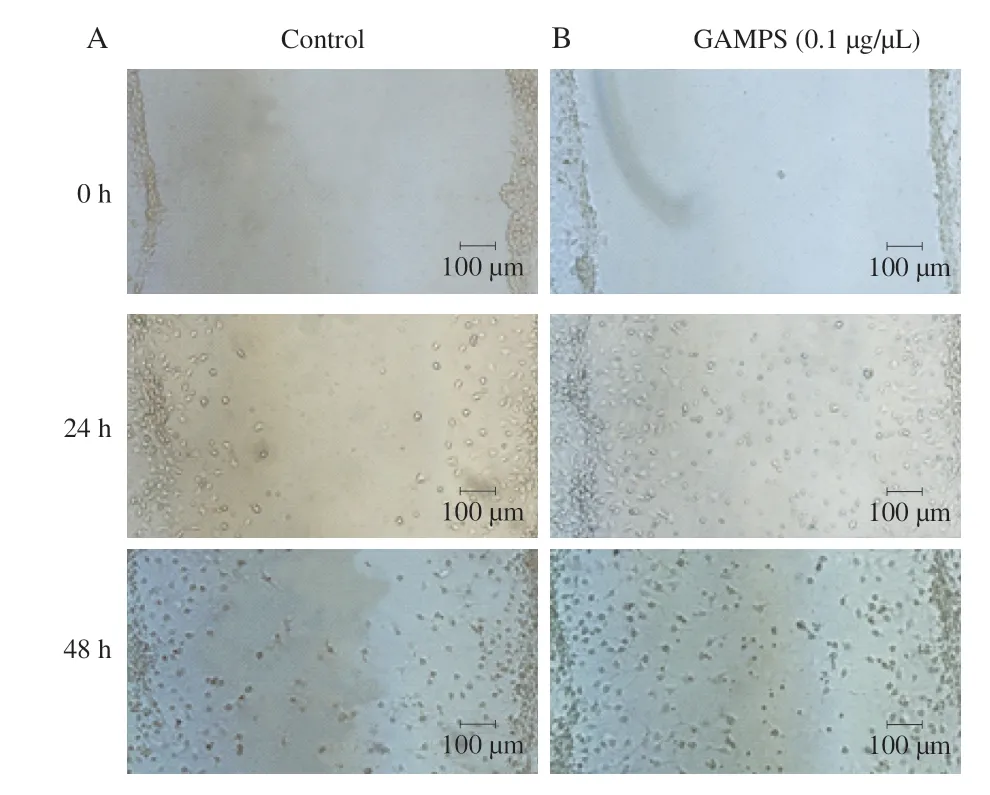The normal cell proliferation and wound healing effect of polysaccharides from Ganoderma amboinense
2021-05-24ShungzhiZhoMingLeiHuiXuHilunHeAlexnderSuvorovJunhuWngJiyingQiuQingxinZhouJinyuYngLeileiChen
Shungzhi Zho, Ming Lei, Hui Xu, Hilun He, Alexnder Suvorov, Junhu Wng, Jiying Qiu, Qingxin Zhou, Jinyu Yng,*, Leilei Chen,*
a Institute of Agro-Food Science and Technology, Shandong Academy of Agricultural Sciences/Key Laboratory of Agro-Products Processing Technology of Shandong Province/Key Laboratory of Novel Food Resources Processing, Ministry of Agriculture and Rural Affairs, Jinan 250100, China
b College of Marine Life Sciences, Ocean University of China, Qingdao 266003, China
c School of Life Science, Central South University, Changsha 410013, China
Keywords:Ganoderma amboinense mycelium polysaccharide Proliferation promotion Wound healing Antioxidant activity
ABSTRACT To study the cell proliferation and wound healing activity of polysaccharides from Ganoderma amboinense (GAMPS), the polysaccharide was extracted by water extraction and alcohol precipitation method, and its monosaccharide composition and molecular weight were analyzed.The effects of different concentrations of GAMPS on the cell proliferation were determined by cell survival rate test, and the wound healing ability of GAMPS to NIH/3T3 cells was detected.The preliminary evaluation of the antioxidant ability of GAMPS was conducted by the oxygen radical absorbance capacity (ORAC).The results showed that the GAMPS was composed of glucose, mannose, and galactose at a molar ratio of 67.62:14.07:7.50, and the weightaverage molecular weights were 5.439 × 106 and 1.704 × 105 g/mol by using high-performance gel-permeation chromatography-multiple angle laser scatter (HPGPC-MALS) analysis.GAMPS (0.2 μg/μL) showed the strongest proliferation ability to THP-1 cells, with cell survival rate of 178.7%.The wound healing effect of GAMPS (0.1 μg/μL) was obvious on NIH/3T3 and 3.75 μg/μL of GAMPS showed the strongest total antioxidant ability .All the results indicate that GAMPS promotes cell proliferation, and has cell wound healing effect and strong antioxidant activity.The results provide theoretical foundation for the development and utilization of GAMPS.
1.Introduction
Ganoderma lucidum, a medicinal fungus belonging to the Polyporaceae family of Basidiomycota phylum, is a precious Chinese medicine with immunomodulatory, anti-aging, and extend lifespan effects.The active components ofG.lucidummainly includeG.lucidumpolysaccharides (GLP), proteins, triterpenoids, and ergosterols [1].G.lucidum(Leyss.ex Fr.) Karst,Ganoderma japonium, andGanoderma amboinenseare the three most commonG.lucidum, among which the fruit body ofG.amboinensehas a stipe without pileus, presents a branch, and looks like the antlers.Previous studies have revealed that GLP and triterpenes are the main active components ofG.lucidum[2-4].GLP purifi ed fromG.lucidumspore powders was composed of glucose and galactose, and 50-400 μg/mL of GLP could promote the proliferation of splenic lymphocytes [5].Researchers have observed that GLP presented a molecular weight distribution of 80-200 kDa [6].Wang et al.[7]used polysaccharides fromGanoderma atrumto gavage mice and they observed thatG.atrumpolysaccharides could improve the immune ability of mice and had a strong antioxidant effect.Furthermore, the effect of GLP on A549 lung cancer cells proliferation inhibition was investigated, and cisplatin combined with GLP had a strong inhibitory effect on A549 cells proliferation was observed [8].
To date, the study on the immune enhancement activity, antioxidant activity, antitumor activity, and cell protective effect ofG.lucidumfruit body and spore powder polysaccharide has been intensively studied [9-12], but the research on polysaccharide from mycelium ofG.amboinense(GAMPS) and its protective effect as well as wound healing effect on cells are rarely reported.The intracellular mycelium polysaccharides produced by the deep liquid fermentation ofG.amboinensehave the advantages of high yield, stable quality, short production cycle, and low cost [13-15].In this study, based on the GAMPS obtained by liquid fermentation, the monosaccharide composition and molecular weight distribution of GAMPS were analyzed, also, its biological activities, such as cell proliferation, cell wound healing effect, and antioxidant activity were analyzed.Specifically, the GAMPS was efficiently extracted, and its monosaccharide composition and molecular weight distribution were analyzed by using high performance liquid chromatography (HPLC) and high-performance gel permeation chromatography (HPGPC), respectively.Additionally, its ability to promote the proliferation of THP-1 cells and its scratch damage repair ability to NIH/3T3 cells were studied at the cellular level.Finally, the mechanism of promoting normal cell proliferation and repairing cell damage was explored by studying the oxygen radical absorbance capacity (ORAC) of GAMPS.This study provided a theoretical basis for the further development and utilization of GAMPS.
2.Materials and methods
2.1 Materials
G.amboinense(NCPSZL1, China Center for Type Culture Collection: No.CCTCC M 2015796); human umbilical vein endothelial cell (HUV-EC-C), mouse embryonic fibroblast cell line (NIH/3T3), human peripheral blood mononuclear cell line (THP-1), and human embryonic kidney cells (293T/17) came from laboratory preservation; Dulbecco’s Modified Eagle Medium (DMEM), 1640 (GIBCO), and sterilized fetal bovine serum (GIBCO) were purchased from Thermo Fisher Scientific Inc.(USA); trypsin, sodium fluorescein, 2,2’-azobis (2-amidinopropane) dihydrochloride (AAPH), mannose (Man), arabinose (Ara), xylose (Xyl), glucose (Glc), and galactose (Gal) were purchased from Sigma company (St.Louis, MO, USA); trifluoroaceticacid (TFA) was purchased from China National Medicines Corporation Ltd.(Beijing, China).
2.2 Preparation of GAMPS
TheG.amboinense(NCPSLZ1) was activated and inoculated onto potato dextrose liquid medium (250 mL of liquid medium contained in a 500 mL triangular flask) at 25 °C.After liquid culture at 120 r/min for 5 days and centrifugation at 10 000 r/min for 10 min, the mycelium was collected.The crude polysaccharide from the mycelium was prepared by water extraction and alcohol precipitation method [16].
The deproteinization of crude polysaccharides was performed by using the Sevag method [17].The supernatant was collected, and the sample was dialyzed using a dialysis bag with molecular weight of 7 kDa to remove the small molecular substances.After dialysis, the sample was centrifuged at 13 000 r/min for 10 min.Finally, the supernatant was collected, and then freeze-dried to obtain the refined GAMPS.The concentration of GAMPS was determined by using phenol-sulfuric acid method.
2.3 Monosaccharide composition analysis of GAMPS
The monosaccharide standards (10 mg/mL) of Glc, Gal, Man, fucose (Fuc), Ara, Xyl, galacturonic acid (GalA), and glucuronic acid (GlcA) were respectively prepared.Then, 5 μL of each of the above monosaccharide standards was mixed and treated with 0.5 mL 2 mol/L TFA solution at 120 °C for 2 h.The product was dried using a pressure blowing concentrator for further use.
Two milligrams of GAMPS was hydrolyzed by 0.5 mL 2 mol/L TFA at 120 °C for 2 h and was dried using a pressure blowing concentrator.0.5 mL 0.5 mol/L 1-phenyl-3-methyl-5-pyrazolone (PMP) reagent (dissolved in anhydrous methanol) and 0.3 mol/L NaOH solution were added into sample, then thoroughly mixed and derived at 70 °C for 30 min.After cooling to room temperature, 0.5 mL 0.3 mol/L hydrochloric acid solution was added and mixed.Furthermore, standard monosaccharides were derived in the same way.
Chloroform (0.5 mL) was added to the pre-treated samples, then fully extracted and centrifuged at 5 000 r/min for 5 min to remove the chloroform layer.This extraction was performed for three times.Subsequently, the water layer (not less than 0.4 mL) was filtered for HPLC analysis.10 μL Monosaccharide-PMP derivatives was conducted on a Waters 1525 HPLC system on the C18column(4.6 mm × 150 mm), and mobile phase was 0.1 mol/L PBS (PH 7.0)/acetonitrile (82:18,V/V) with flow rate of 1.0 mL/min at 245 nm.The derivative sample of monosaccharide standard was considered as a reference to determine the monosaccharide composition of GAMPS, and the molar ratio between the corresponding monosaccharides was calculated according to the peak area of each monosaccharide peak.
2.4 Molecular weight distribution determination of GAMPS
The molecular weight and molecular weight distribution of GAMPS were detected by HPGPC-Wyatt Heleos System Laser detector connected with differential refractive index detector.The lyophilized samples of GAMPS were dissolved in three-distilled water and filtered with a 0.22 μm filter membrane.The separation was achieved on Shodex SB-806HQ tandem SB-803HQ chromatographic column (300 mm × 7.8 mm) using a mobile phase of 0.05 mol/L KH2PO4with a flow rate of 1.0 mL/min at 35 °C, and the injection volume was 500 μL.Laser scattering signal and differential refraction index were collected, respectively, and data analysis was performed with the supporting work station software.
2.5 Evaluation the proliferation ability of GAMPS
In order to explore the proliferation ability of GAMPS to normal cells, 4 normal cell lines, including 293T/17, HUV-EC-C, NIH/3T3, and THP-1, were treated with 3 different concentrations of GAMPS.
The cells were separately cultivated to logarithmic growth period, then were digested with trypsin and dispensed into 96-well plates.The inoculation amount of cells per well was approximately 1 × 104-2 × 104.Afterwards, the volume of each well was supplemented to 200 μL using culture medium and incubated at 37 °C for 12 h.GAMPS with concentration of 0, 0.02, 0.10, and 0.20 μg/μL were added, respectively, and 6 replicates were set for each concentration, then incubated with cells for 24 h.After culture, 10 μL 5 μg/μL MTT solution was added and incubated at 37 °C for 4 h.Then, the supernatant was discarded and washed with PBS for 3 times.Finally, 150 μL of DMSO was added to each well and shaken for 10 min.After the crystals were completely dissolved, the absorbance value was determined at 490 nm and the cell survival rate was calculated.The experiments were repeated 5 times and averages were calculated as the final results.The survival rate of cells was calculated from the following equation:

in whichASamplerepresented the absorbance value of test group, and theAControlrepresented the absorbance value of control group.
2.6 Wound healing assay of GAMPS to NIH/3T3 cells
NIH/3T3 cells were seeded at a 6-well cell culture plate and cultured for 48 h.When the cell density reached more than 90%, a 10 μL sterile pipette tip was used to produce cell scratch damage, and the culture medium was changed by serum-free medium supplemented with 0.1 μg/μL of GAMPS.Cell migration was observed at 0, 24, and 48 h, and 4 fields of view were selected for data statistics.
2.7 ORAC test of GAMPS
The ORAC assay was performed using the method described by Davalos et al [18].The tested groups were diluted to the appropriate concentration with a 50 mmol/L PBS.20 μL PBS was added to the 96-well plate as the blank control and Trolox standard (20 μL, 15 μg/mL) was added as a positive control.Then, 20 μL of different concentrations of GAMPS (1.25, 2.50, 3.75 μg/μL) was added, then 150 μL of sodium fluorescein (96 nmol/L) was added and the solution was bathed at 37 °C for 5 min.Subsequently, 30 μL 320 mmol/L of AAPH solution was added.The fluorescence intensity of each well was continuously detected at an excitation wavelength of 485 nm and an emission wavelength of 538 nm, and repeated every 30 s for a total of 300 cycles to detect the fluorescence attenuation.Trolox was used as the reference system of antioxidant activity to calculate the antioxidant equivalent (μmol TE/g) of tested samples, that is, the antioxidant capacity per gram of the sample was equivalent to the antioxidant activity of the corresponding micro molar Trolox.The ORAC value of GAMPS was calculated as follows:

Among which, AUC represented the integral area under the fluorescence quenching curve of the sample.AUCSampleindicated the integral area of the test group,AUCControlindicated the integral area of the control group,AUCTroloxindicated the integral area of groups added Trolox,MTroloxindicated the molality concentration of Trolox standard, andMSampleindicated the molality concentration of the sample.
2.8 Statistical analysis
The survival rate and growth rate of cells were calculated according to the experimental results.The integrated area AUC under the ORAC fluorescence quenching curve of GAMPS was calculated using the curve integral area method in Origin 9.0 software.SPSS 16.0 statistical software was used for statistical analysis.
3.Results and discussion
3.1 Monosaccharide composition of GAMPS
After acidolysis, the PMP derivative was tested by HPLC to obtain the monosaccharide composition and molar percentage of GAMPS.As shown in Table 1, the GAMPS was mainly composed of Glc, Man, and Gal at a molar ratio of 67.62:14.07:7.50, which was different from the monosaccharide composition of the GLP reported previously [19,20].Due to the different species ofG.lucidum, their differences in the monosaccharides composition and other physicochemical properties might be closely related to their specific functions.Thus, the in-depth study of GAMPS is of great significance.

Table 1 Glycosyl composition of the GAMPS.
3.2 Molecular weight distribution of GAMPS
Molecular weight is an important physicochemical index of polysaccharides, and molecular weight distribution of polysaccharides are usually different among different polysaccharide sources [21-24].The molecular weight distribution of GAMPS was determined by HPGPC-permeation chromatography-multiple angle laser scatter (HPGPC-MALS) analysis.As shown in Fig.1, despite multiple absorption peaks were formed on the differential spectrum, the molecular weight distribution of GAMPS was concentrated on two peaks in the laser scattering spectrum.Furthermore, the weight average relative molecular weight (Mw) and number average relative molecular weight (Mn) are listed in Table 2.The Mw distribution of GAMPS was 5.439 × 106and 1.704 × 105g/mol, indicating that GAMPS mostly existed as high molecular weight polysaccharides.The cumulative distribution of peak 1 is 13.8%, and peak 2 is 80.7%.

Fig.1 HPGPC-MALS profiles of GAMPS.

Table 2 Molecular weight of GAMPS.
3.3 Proliferation ability of GAMPS to normal cells
The activity of water-soluble GLP was correlated with the molecular weight distribution to some extent.GLP with high molecular weight usually has more biologically active.Generally, the molecular weight of active GLP is greater than 1.0 × 104g/mol, otherwise, the activity is very low or even inactive [25-29].In this study, the GAMPS obtained by water extraction and alcohol precipitation method was high molecular weight polysaccharides with molecular weights of 5.439 × 106and 1.704 × 105g/mol, which provided the possibility of the cell proliferation-promoting activity of GAMPS.In order to evaluate the proliferative activity of GAMPS on normal cells, 4 normal cells (293T/17, HUv-EC-C, NIH/3T3, and THP-1) were treated with a series of concentration gradient polysaccharide solutions.As displayed in Fig.2, 0.02-0.2 μg/μL of GAMPS could obviously promote the proliferation of these 4 cells.At a GAMPS concentration of 0.1 μg/μL, it had the strongest proliferation ability to NIH/3T3, and the rate of cell survival was 141.0%.At a concentration of 0.2 μg/μL, it had the strongest proliferation ability to HUV-EC-C, THP-1, and 293T/17, and the rate of cell survival was 144.9%, 178.7%, and 157.8%, respectively.The survival rate of HUV-EC-C, THP-1, and 293T/17 significantly increased with the increasing of GAMPS concentrations, among which, it had the best growth-promoting effect on THP-1.These results indicated that GAMPS had the proliferation ability to normal cells.
3.4 Wound healing ability of GAMPS to NIH/3T3
In order to investigate whether the GAMPS could promote the migration of NIH/3T3 cells, the wound healing assay was used to explore the effect of GAMPS (0.1 μg/μL) on the migration of NIH/3T3 cells after scratch injury.As shown in Fig.3, in serumfree medium, NIH/3T3 cells began to migrate after being injured.When the low concentration of GAMPS (0.1 μg/μL) was added, the gap basically healed after 24 h; while the cells in PBS control group were still not overgrown after 48 h.Therefore, low concentration of GAMPS (0.1 μg/μL) had effect on promoting migration and repairing the scratch damage on NIH/3T3 cells.

Fig.2 The survival rate analysis of normal cell treated with GAMPS.(A) NIH/3T3, (B) HUV-EC-C, (C) THP-1, (D) 293T/17.*P < 0.05, **P < 0.01 and ***P < 0.001 versus normal group.

Fig.3 Damage repair effect of GAMPS on fibroblast cells NIH/3T3.(A) Control group; (B) GAMPS (0.1 μg/μL) group.
3.5 ORAC of GAMPS
In order to evaluate the ORAC of GAMPS, PBS buffer was used as blank control and Trolox as positive control to detect the fluorescence intensity of GAMPS with different concentrations, and the fluorescence attenuation was recorded.The integrated area AUC of the ORAC fluorescence quenching curve of the GAMPS with different concentrations and Trolox was calculated to obtain the Trolox equivalent of the ORAC of GAMPS.As shown in Table 3, GAMPS could inhibit the fluorescence changes caused by free radicals, and the inhibition ability was enhanced with the increase of concentration of GAMPS, indicating that GAMPS had a strong ORAC.

Table 3 The ORAC of GAMPS.
Ma et al.[26]indicated that the ORAC value of GLP was 1 956 μmol TE/g.In Table 3, ORAC value of GAMPS was much higher than that reported in the literature.It could be seen that the GAMPS prepared by liquid submerged fermentation had higher antioxidant ability.This result was in accordance with the previous study that GLP had protective effect on oxidative damage of cells [12].
4.Conclusion
In the present study, the mycelium ofG.amboinensewas obtained using submerged liquid fermentation and the GAMPS was prepared by using water extraction and alcohol precipitation method.After detecting, the molecular weight of GAMPS was 5.439 × 106and 1.704 × 105g/mol.In addition, the GAMPS was composed of Glc, Man and Gal at a molar ratio of 67.62:14.07:7.50.The GAMPS at concentration of 0.02-0.2 μg/μL could promote the 4 normal cells proliferation, including NIH/3T3, HUV-EC-C, THP-1, and 293T/17.Meanwhile, 0.1 μg/μL of GAMPS showed high wound healing activity of fibroblast NIH/3T3.The ORAC of GAMPS indicating that it has a strong antioxidant activity.This study provided a theoretical basis for the development and utilization of GAMPS, which is prepared with submerged liquid fermentation.
Conflicts of Interest
The authors declare no conflicts of interests.
Acknowledgements
This research was supported by the National Key Research and Development Program of China (2017YFC1601400), Shandong Provincial Key Research and Development Program (2019GHZ022), Taishan Scholar Program of Shandong Province (tsqn201909168), and “Double Hundred” Program for Foreign Experts of Shandong Province (WST2017004).
杂志排行
食品科学与人类健康(英文)的其它文章
- Antioxidative and hepatoprotective activities of a novel polysaccharide (LSAP) from Lepista sordida mycelia
- Amelioration of metabolic disorders by a mushroom-derived polyphenols correlates with the reduction of Ruminococcaceae in gut of DIO mice
- Immunomodulatory effects of polysaccharides from edible fungus: a review
- Advances in research on chemical constituents and pharmacological effects of Paecilomyces hepiali
- Healthy function and high valued utilization of edible fungi
- Antrodia Cinnamomea ameliorates neointimal formation by inhibiting infl ammatory cell infi ltration through downregulation of adhesion molecule expression in vitro and in vivo
